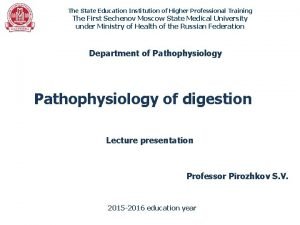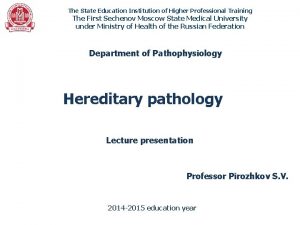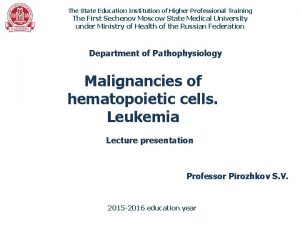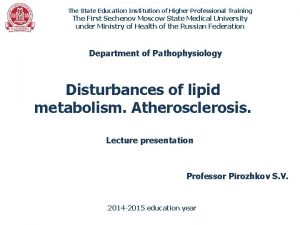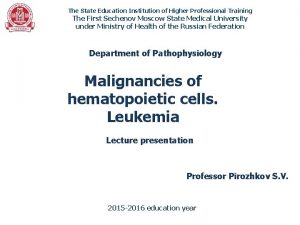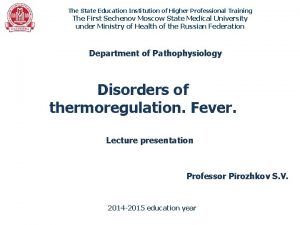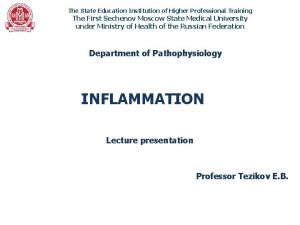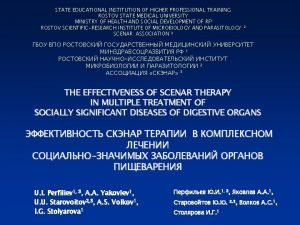The State Education Institution of Higher Professional Training














- Slides: 14

The State Education Institution of Higher Professional Training The First Sechenov Moscow State Medical University under Ministry of Health of the Russian Federation Department of Pathophysiology Leukocytosis. Leukopenia. Lecture presentation Professor Pirozhkov S. V. 2015 -2016 education year

Scheme of hematopoiesis Lymphocyte Lymphoid stem cell CFU eryth. Pluripotent stem cell of hematopoiesis Erythroblast Erythrocyte Myeloblast Neutrophil Monoblast Мonocyte Eosinoblast Eosinophil CFU g/m Myeloid stem cell CFU eosin. CFU basoph. Basophiloblast CFU mega. Basophil Platelets Megakaryoblast Megakaryocyte

Stages of neutrophilic myelopoiesis Cell Stage Characteristics Myeloblast The nucleus with the nucleoli Promyelocyte Large cell, primary granules appear Myelocyte Secondary granules appear Metamyelocyte Bean-like nucleus Band neutrophil Condensed band-like nucleus Segmented neutrophil Condensed segmented nucleus

Composition of granules in neutrophils ■ Primary (azurophil) granules: - myeloperoxidase - lyzozyme - cationic protein - acid hydrolase - elastase - nonspecific collagenase - defensines - cathepsin G - phospholipase А 2 ■ Secondary (specific) granules: - lactoferrin - lyzozyme - alkaline phosphotase - collagenase type IV - leukocyte adhesive molecules - plasminogen activator - phospholipase А 2 AG

DISORDERS OF THE LEUKOCYTE SYSTEM QUANTITATIVE Leukocytosis > 9*109 cells/L of blood Leukopenia < 4*109 cells/L of blood QUALITATIVE Functional disorders of leukocytes Nuclear shifts

Types of leukocytosis based on their biological significance Physiological Protective/adaptive Functional Pathological

MECHANISMS OF LEUKOCYTOSIS Leukocytosis Increased mobilization from the bone marrow pool Stimulation of leukopoiesis “True” leukocytosis Mobilization from the marginal pool in the vessels (demargination) Hemoconcentration “False” leukocytosis

Causes of the stimulation of hematopoiesis ● Infection causes by: - bacteria - fungi - viruses (less commonly) ● Inflammatory process: - burns acute myocardial infarction allergy vasculitis ● Myeloproliferative diseases

Types of nuclear shift to the left ◙ Hyporegenerative: - increase in band neutrophils in the peripheral blood > 6% - slight leukocytosis in the range of 10 -11*109/l ◙ Regenerative: - increase in band neutrophils and emergence of metamyelocites - moderate leukocytosis in the range of 13 -18*109/l ◙ Hyperregenerative: - considerable increase in band neutrophils, large amount of metamyelocytes, emergence of myelocytes - leukocytosis in the range of 20 -25*109/l

Causes of increased mobilization of leukocytes from the marginal pool in the vessels (demargination) ► Use of medicines: - epinephrine - glucocorticoids - non-steroidal untiinflammatory drugs ► Psychological and physical stress ►Hereditary deficit of adhesive molecules on the surface of leukocytes

Basophilia - > 0. 2*109 basophils/l of blood ● occurs rarely, usually indicates the presence of myeloproliferative disease Monocytosis - > 1*109 monocytes/l of blood ● chronic infection (tuberculosis etc. ) ● bacterial endocarditis ● rickettsiosis, malaria ● vasculitis (SLE etc. ) ● inflammatory diseases of the intestine (ulcerative colitis) Lymphocytosis - > 4*109 lymphocytes/l of blood ● accompanies monocytosis in many diseases associated with chronic stimulation of the immune system (tuberculosis, brucellosis etc. ) ● viral infections (HAV, Epstein-Barr virus, cytomegalovirus)

МECHANISMS OF LEUKOPENIA Leukopenia Intense destruction of leukocytes in the circulation or hematopoietic organs Impairment of leukopoiesis Increased utilization of leukocytes or loss in the external media “True” leukopenia Redistribution in the vessels Hemodilution “False” leukopenia

Manifestations and negative consequences of neutropenia ● Malaise, fever ● Weakness, fatigue ● Severe infections (when the leukocytes counts < 0. 5*109/l) ● Ulcerative-necrotic lesions of the mucous membrane of the gingivae, oral cavity and pharynx (agranulocytic pharyngitis) ● Skin infection – small superficial pyogenic abscesses (furunculosis), bacterial invasion of the dermis (cellulitis)

Disorders of the function of granulocytes/monocytes: • Abnormal adhesion/aggregation • Abnormal microbicidal activity, processing and presentation of antigens • Abnormal chemokinesis/chemotaxis or ability to change shape (deformability)
 Formal institution and informal institution
Formal institution and informal institution Department of higher education and training
Department of higher education and training Training for higher education professionals
Training for higher education professionals Federal state autonomous educational institution
Federal state autonomous educational institution Hidden curriculum in education
Hidden curriculum in education Web analytics for higher education
Web analytics for higher education Capacity building in the field of higher education
Capacity building in the field of higher education Importance of faculty in higher education
Importance of faculty in higher education Rhode island board of governors for higher education
Rhode island board of governors for higher education Ppc for higher education
Ppc for higher education Ministry of higher education (afghanistan)
Ministry of higher education (afghanistan) Massachusetts higher education consortium
Massachusetts higher education consortium Ministry of education krg
Ministry of education krg Kurdistan
Kurdistan Kurdistan higher education
Kurdistan higher education















